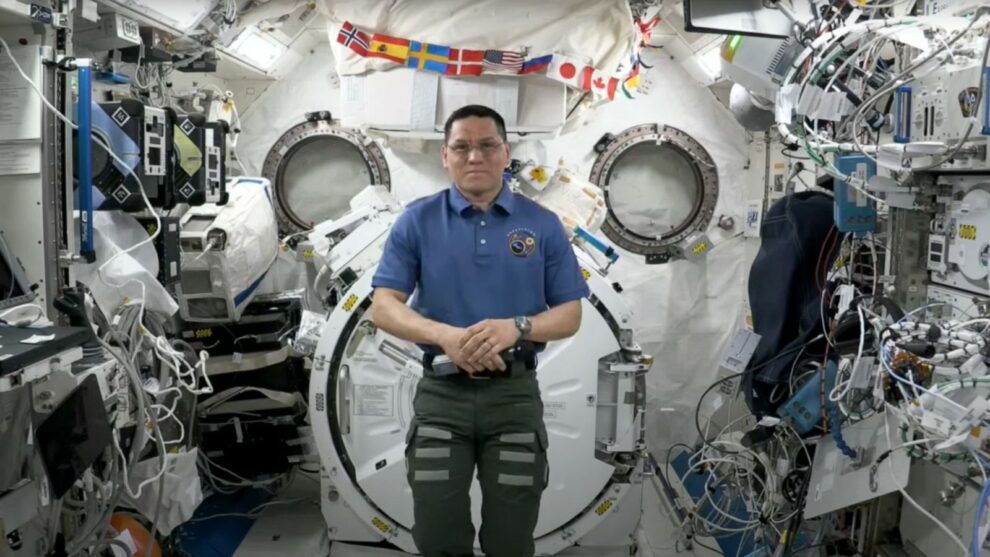Record-breaking NASA astronaut Frank Rubio has finally returned to Earth, feeling the pull of the planet’s gravity for the first time in more than a year.
Rubio and his two Russian colleagues — cosmonauts Sergey Prokopyev and Dmitri Petelin — parachuted to a landing in Kazakhstan aboard the Russian Soyuz MS-23 capsule at 5:17 p.m. local time (7:17 a.m. ET) on Wednesday.
The crew’s arrival marked the end of a long — and unexpected — journey for Rubio, who had been slated to spend only six months aboard the International Space Station. He instead logged a total of 371 days in space following the discovery of a coolant leak coming from his original ride while docked to the orbiting outpost.

NASA astronaut Frank Rubio (left) and Roscosmos cosmonauts Sergey Prokopyev (center) and Dmitri Petelin sit in chairs outside the Soyuz MS-23 spacecraft after they landed in a remote area near the town of Zhezkazgan, Kazakhstan on Wednesday.Bill Ingalls/NASA
Rubio’s stay set a new record for the longest a US astronaut has ever spent in microgravity. He also became the first American to log an entire calendar year in orbit.
His record-breaking mission also marked other notable firsts for Rubio: This was his first journey to space after being selected for the NASA astronaut corps in 2017, and at the outset of the mission, he became the first astronaut of Salvadoran origin to travel to low-Earth orbit.
In a recent interview with CNN, Rubio said that if he had known his stay on the space station would be twice as long as originally planned, he “probably would have declined” the assignment before he began training.
“And that’s only because of family things that were going on this past year,” he said. “And if I had known that I would have had to miss those very important events, I just would have had to say, ‘thank you, but no thank you.’”
Rubio, who has four children, is now expected to begin the journey home from the Soyuz spacecraft’s landing site near the town of Dzhezkazgan in Kazakhstan. He will first fly to Karaganda, which lies about 330 miles (530 kilometers) northeast of Dzhezkazgan, before boarding a flight to Houston.
All told, Rubio and his crewmates traveled 157.4 million miles (253.3 million kilometers) and completed 5,963 orbits of the Earth, according to NASA.
Rubio bested the previous record for the longest stay in space by a US astronaut — 355 days — which was set by NASA’s Mark Vande Hei in 2022.
The late Russian cosmonaut Valeri Polyakov, who logged 437 continuous days in orbit aboard Russia’s Mir space station between January 1994 and March 1995 , holds the world record for the longest stay in space.
US and Russian cooperation in space
Rubio traveled to the space station on a Russian spacecraft as part of ride-sharing agreement between NASA and Roscosmos, the Russian space agency, that was hashed out in the summer of 2022 amid Russia’s invasion of Ukraine. The seat-swap arrangement was an effort to continue longstanding policies that have sought to ensure access to the space station for both the United States and Russia — the primary operators of the outpost — should either country experience spacecraft issues that left their astronauts grounded.
Rubio, Prokopyev and Petelin launched aboard the Soyuz MS-22 vehicle on September 21, 2022, and safely arrived at the ISS three hours later, leaving the Soyuz capsule docked to the space station’s exterior as they went to work aboard the orbiting laboratory.
In an interview with reporters last week, Rubio thanked his family, noting their “resilience and strength has carried me through this entire mission.”
Increasing risk from space debris
Less than three months into its crew’s mission, the Soyuz MS-22 began spewing coolant. Investigations by Roscosmos, which were reviewed by NASA later, determined that the spacecraft was likely struck by a small object in orbit. The culprit was determined to be a micrometeorite or a piece of orbital debris, a growing threat in the increasingly congested environment of low-Earth orbit.
The Soyuz MS-22 spacecraft was deemed unfit to return the astronauts, and Roscosmos quickly worked to launch a replacement vehicle — the Soyuz MS-23 — in February.

A view shows the Soyuz MS-23 spacecraft (on left) that carried Roscosmos cosmonauts Sergey Prokopyev and Dmitry Petelin and NASA astronaut Frank Rubio back to Earth.Konstantin Borisov/Roscosmos/Reuters
But Rubio and his colleagues couldn’t return home yet: Officials determined that they would instead extend their stay as Roscosmos prepared for yet another Soyuz capsule to launch a fresh crew to replace them.
Space station crew rotation
The Soyuz MS-24 vehicle was finally ready this month and carried NASA astronaut Loral O’Hara and Roscosmos cosmonauts Oleg Kononenko and Nikolai Chub to the space station on September 15, paving the way for Rubio’s return on Wednesday.
Rubio, a medical doctor and military helicopter pilot with more than 600 hours of combat experience, acknowledged that he likely will not be immediately returning to his pre-spaceflight life upon return because of the affects that long stints in microgravity can have on the body.
“We’re not walking, we’re not bearing our own weight (while in space), and so it’ll be anywhere from two to six months before I essentially say that I feel normal,” he said.
But there are plenty of earthly treasures he is looking forward to experiencing: “Up here we kind of have the constant hum of machinery that’s keeping us alive,” he said during an interview from space. “And so I’m looking forward to just being outside and enjoying the peace and quiet.”
Source : CNN
















